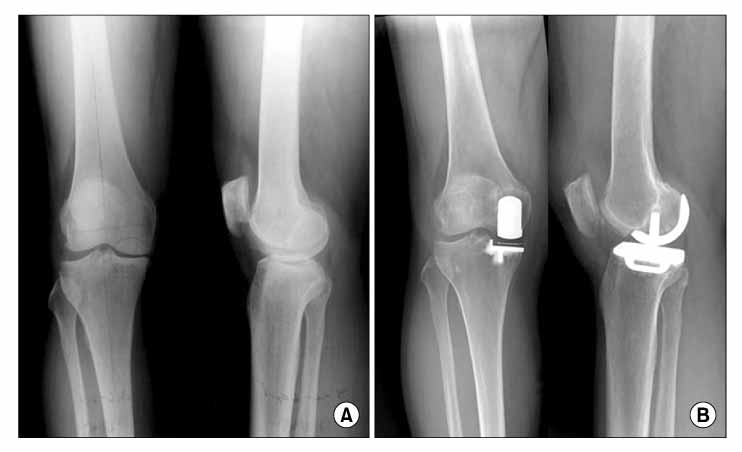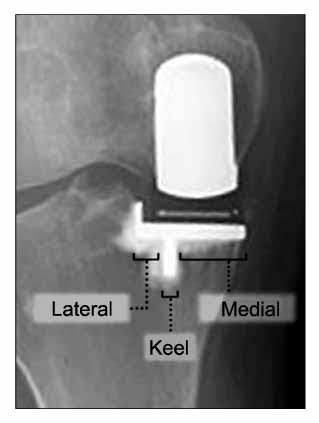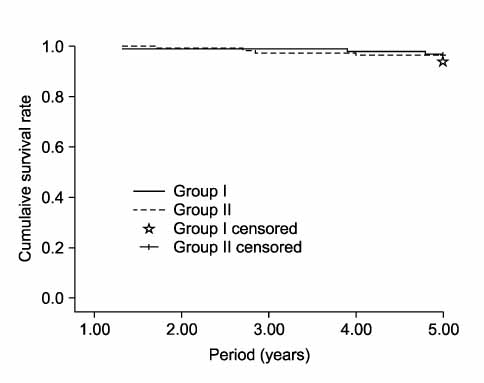J Korean Orthop Assoc.
2009 Apr;44(2):192-200.
Comparative Study for the Results of Unicompartmental Knee Arthroplasty in Patients Younger and Older than 60 Years of Age
- Affiliations
-
- 1Department of Orthopedic Surgery, Seoul Sacred Heart General Hospital, Seoul, Korea. kktkimos@hanmail.net
Abstract
- PURPOSE
We wanted to assess the relations between age and the outcome of unicompartmental knee arthroplasty (UKA) based on a comparative study of UKA patients younger than 60 years and UKA patients older than 60 years of age. MATERIALS AND METHODS: Among the patients who underwent a UKA between January 2002 and June 2003, 230 cases (the group of patients with ages under sixty consisted of 89 knees - group I, and the group of patients with ages over sixty consisted of 141 knees - group II) were followed up for at least 5 years after the operation. Clinical assessments were made using the Knee Society Score (KSS) rating system. RESULTS: The average KSS knee and function scores improved from 54.2 and 57.1 preoperatively to 87.3 and 85.2 at the last follow-up in group I, and from 54.7 and 54.3 to 89.5 and 81.7 in group II, respectively. The mean range of knee motion also improved from 129.4degrees to 132.9degrees in group I and from 126.8degrees to 133.2degrees in group II, respectively. There were 5 cases of failed UKAs in each group, and the survival rate of the implant at 5 years was 94.7% in group I and 96.6% in group II. CONCLUSION: The clinical results of UKA were satisfactory in both age groups. Group I had better results on the knee function score at the last follow-up, but there was no significant difference between both age groups. UKA can be a one of the reliable methods for the treatment of osteoarthritis in patients younger than 60 years of age.
Keyword
Figure
Reference
-
1. Berend KT, Lombardi AV Jr, Adams JB. Obesity, young age, patellofemoral disease, and anterior knee pain: identifying the unicondylar arthroplasty patient in the United States. Orthopedics. 2007. 30:Suppl 5. S19–S23.2. Berend KR, Lombardi AV Jr, Mallory TH, Adams JB, Groseth KL. Early failure of minimally invasive unicompartmental knee arthroplasty is associated with obesity. Clin Orthop Relat Res. 2005. 440:60–66.
Article3. Berger RA, Meneghini RM, Jacobs JJ, et al. Results of unicompartmental knee arthroplasty at a minimum of ten years of follow-up. J Bone Joint Surg Am. 2005. 87:999–1006.
Article4. Carr A, Keyes G, Miller R, O'Connor J, Goodfellow J. Medial unicompartmental knee arthroplasty. A survival study of the Oxford meniscal knee. Clin Orthop Relat Res. 1993. 295:205–213.5. Emerson RH Jr, Higgins LL. Unicompartmental knee arthroplasty with the Oxford prosthesis in patients with medial compartment arthritis. J Bone Joint Surg Am. 2008. 90:118–122.
Article6. Engh GA, McAuley JP. Unicondylar arthroplasty: an option for high-demand patients with gonoarthrosis. Instr Course Lect. 1999. 48:143–148.7. Hanssen AD, Suart MJ, Scott RD, Scuderi GR. Surgical options for the middle-aged patient with osteoarthritis of the knee joint. J Bone Joint Surg Am. 2000. 82:1768–1781.
Article8. Hodge WA, Chandler HP. Unicompartmental knee replacement: a comparison of constrained and unconstraind designs. J Bone Joint Surg Am. 1992. 74:877–883.9. Insall JN, Dorr LD, Scott RD, Scott WN. Rationale of the knee society clinical rating system. Clin Orthop Relat Res. 1989. 248:13–14.
Article10. Karpman RR, Volz RG. Osteotomy versus unicompartmental prosthetic replacement in the treatment of unicompartmental arthritis of the knee. Orthopedics. 1982. 5:989–992.11. Kim KT, Lee S, Bae EH, Kim HS, Park HS, Park KY. Short-term results and early complications of minimally invasive unicompartmental knee arthroplasty. J Korean Knee Soc. 2005. 17:119–126.12. Kim KT, Lee S, Park HS, Cho KH, Kim KS. A prospective analysis of Oxford phase 3 unicompartmental knee arthroplasty. Orthopedics. 2007. 30:Suppl 5. S15–S18.13. Kort NP, van Raay JJ, Cheung J, Jolink C, Deutman R. Analysis of Oxford medial unicompartmental knee replacement using the minimally invasive technique in patients aged 60 and above: an independent prospective series. Knee Surg Sports Traumatol Arthrosc. 2007. 15:1331–1334.
Article14. Kort NP, van Raay JJ, van Horn JJ. The Oxford phase III unicompartmental knee replacement in patients less than 60 years of age. Knee Surg Sports Traumatol Arthrosc. 2007. 15:356–360.15. Kozinn SC, Scott R. Unicondylar knee arthroplasty. J Bone Joint Surg Am. 1989. 71:145–150.
Article16. Levine WN, Ozuna RM, Scott RD, Thornhill TS. Conversion of failed modern unicompartmental arthroplasty to total knee arthroplasty. J Arthroplasty. 1996. 11:797–801.17. Martin JG, Wallace DA, Woods DA, Carr AJ, Murray DW. Revision of unicondylar knee replacements to total knee replacements. Knee. 1995. 2:121–125.18. Murray DW. Mobile bearing unicompartmental knee replacement. Orthopedics. 2005. 28:985–987.
Article19. O'Rourke MR, Gardner JJ, Callaghan JJ, et al. The John Install Award: unicompartmental knee replacement: a minimum twenty-one-year followup, end-result study. Clin Orthop Relat Res. 2005. 440:27–37.20. Pandit H, Jenkins C, Barker K, Dodd CA, Murray DW. The Oxford medial unicompartmental knee replacement using a minimally-invasive approach. J Bone Joint Surg Br. 2006. 88:54–60.
Article21. Pennington DW, Swienckowski JJ, Lutes WB, Drake GN. Unicompartmental knee arthroplasty in patients sixty years of age or younger. J Bone Joint Surg Am. 2003. 85:1968–1973.
Article22. Price AJ, Dodd CA, Svard UG, Murray DW. Oxford medial unicompartmental knee arthroplasty in patients younger and older than 60 years of age. J Bone Joint Surg Br. 2005. 87:1488–1492.
Article23. Price AJ, Waite JC, Svard U. Long-term clinical results of the medial Oxford unicompartmental knee arthroplasty. Clin Orthop Relat Res. 2005. 435:171–180.
Article24. Rea P, Short A, Pandit H, et al. Radiolucency and migration after Oxford unicompartmental knee arthroplasty. Orthopedics. 2007. 30:Suppl 5. S24–S27.25. Repicci JA, Eberle RW. Minimally invasive surgical technique for unicondylart knee arthroplasty. J South Orthop Assoc. 1999. 8:20–27.26. Schai PA, Suh JT, Thornhill TS, Scott RD. Unicompartmental knee arthroplasty in middle-aged patients: a 2- to 6-year follow-up evaluation. J Arthroplasty. 1998. 13:365–372.27. Schmalzried TP, Szuszczewicz ES, Northfield MR, et al. Quantitative assessment of walking activity after total hip or knee replacement. J Bone Joint Surg Am. 1998. 80:54–59.
Article28. Scott RD, Cobb AG, McQueary FG, Thornhill TS. Unicompartmental knee arthroplasty. Eight- to 12-year follow-up evaluation with survivorship analysis. Clin Orthop Relat Res. 1991. 271:96–100.29. Seedhom BB, Wallbridge NC. Walking activities and wear of prostheses. Ann Rheumat Dis. 1985. 44:838–843.
Article30. Tabor OB Jr, Tabor OB. Unicompartmental arthroplasty: a long-term follow-up study. J Arthroplasty. 1998. 13:373–379.31. Vardi G, Strover AE. Early complications of unicompartmental knee replacement: the Droitwich experience. Knee. 2004. 11:389–394.32. Vince KG, Cyran LT. Unicompartmental knee arthroplasty: new indications, more complications? J Arthroplasty. 2004. 19(4):Suppl 1. S9–S16.
- Full Text Links
- Actions
-
Cited
- CITED
-
- Close
- Share
- Similar articles
-
- Long-Term Clinical Results of Unicompartmental Knee Arthroplasty in Patients Younger than 60 Years of Age: Minimum 10-Year Follow-up
- Dislocation of the Polyethylene Bearing of the Medial Unicompartmental Knee Arthroplasty: A Case Report
- Clinical Results of Unicompartmental Knee Arthroplasty
- Comparative analysis between inset and L-cut method of unicompartmental knee arthroplasty
- Early Major Complications Following Unicompartmental Knee Arthroplasty: Three Case Reports




